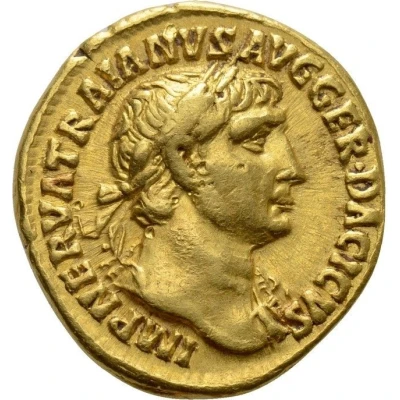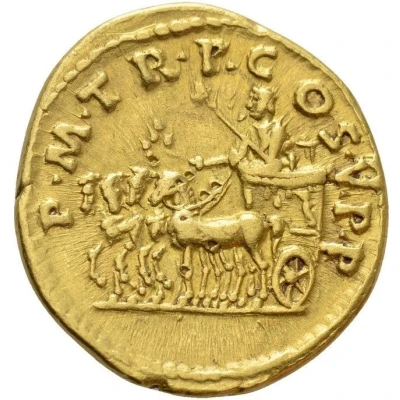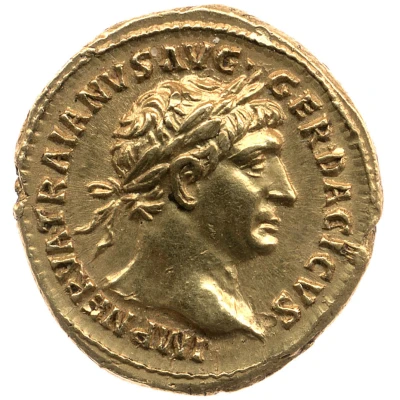


© Numismatik Naumann GmbH
Aureus - Trajan P M TR P COS V P P
| Gold | 7.15 g | 19 mm |
| Issuer | Rome › Roman Empire (27 BC - 395 AD) |
|---|---|
| Emperor | Trajan (Marcus Ulpius Traianus) (98-117) |
| Type | Standard circulation coin |
| Years | 103-111 |
| Value | 1 Aureus = 25 Denarii |
| Currency | Denarius, Reform of Augustus (27 BC – AD 215) |
| Composition | Gold |
| Weight | 7.15 g |
| Diameter | 19 mm |
| Shape | Round (irregular) |
| Technique | Hammered |
| Demonetized | Yes |
| Updated | 2024-10-05 |
| Numista | N#252971 |
|---|---|
| Rarity index | 100% |
Reverse
Trajan standing in quadriga left, holding branch and sceptre.
Script: Latin
Lettering: P M TR P COS V P P
Translation:
Pontifex Maximus, Tribunicia Potestate, Consul Quintum, Pater Patriae.
High priest, holder of tribunician power, consul for the fifth time, father of the nation.
Comment
Source: Online Coins of the Roman Empire (OCRE)Interesting fact
The Aureus was a gold coin used in the Roman Empire, and it was first introduced during the reign of Emperor Trajan, who ruled from 98 to 117 AD. The Aureus was equivalent to 25 silver denarii, and it was used as a means of payment for high-value transactions, such as buying property or paying taxes. The coin was made of gold, which was a valuable and prestigious metal at the time, and it was used to symbolize the wealth and power of the Roman Empire. The Aureus - Trajan (P M TR P COS V P P) (103-111) coin is particularly interesting because it features an image of Emperor Trajan on one side, and the Roman goddess Victory on the other. The coin also has an inscription that reads "P M TR P COS V P P," which stands for "Pater Patriae, Marcus Traianus, Pontifex Maximus, Consul Quintum, Pater Placitorum," which means "Father of the Fatherland, Marcus Traianus, Supreme Pontiff, Fifth Consul, Father of the People." This inscription highlights Trajan's status as a powerful and influential leader in the Roman Empire. Overall, the Aureus - Trajan (P M TR P COS V P P) (103-111) coin is a fascinating piece of history that provides insight into the economy, politics, and culture of the Roman Empire during the 2nd century AD.



